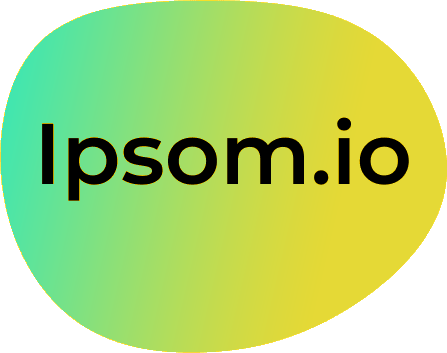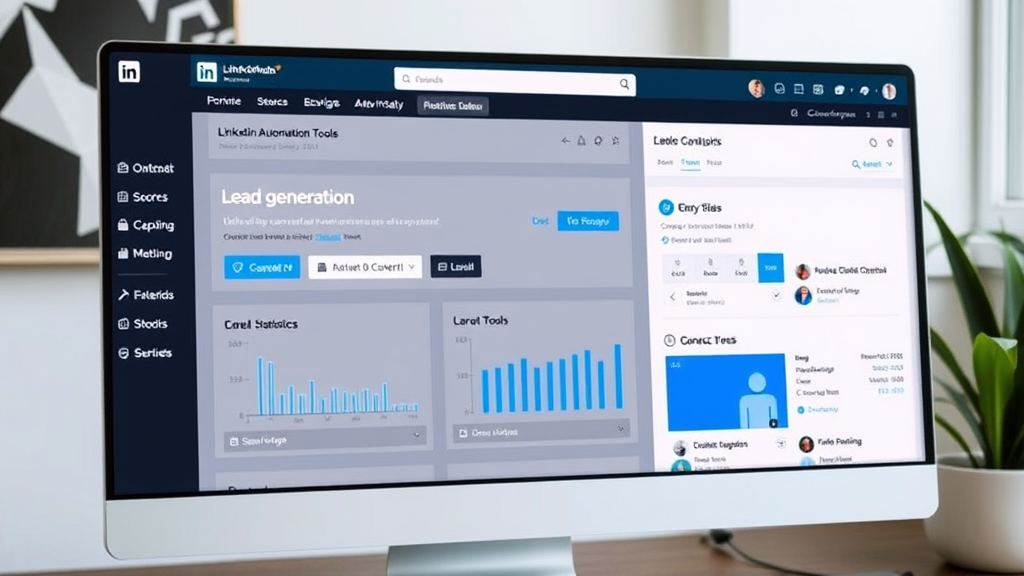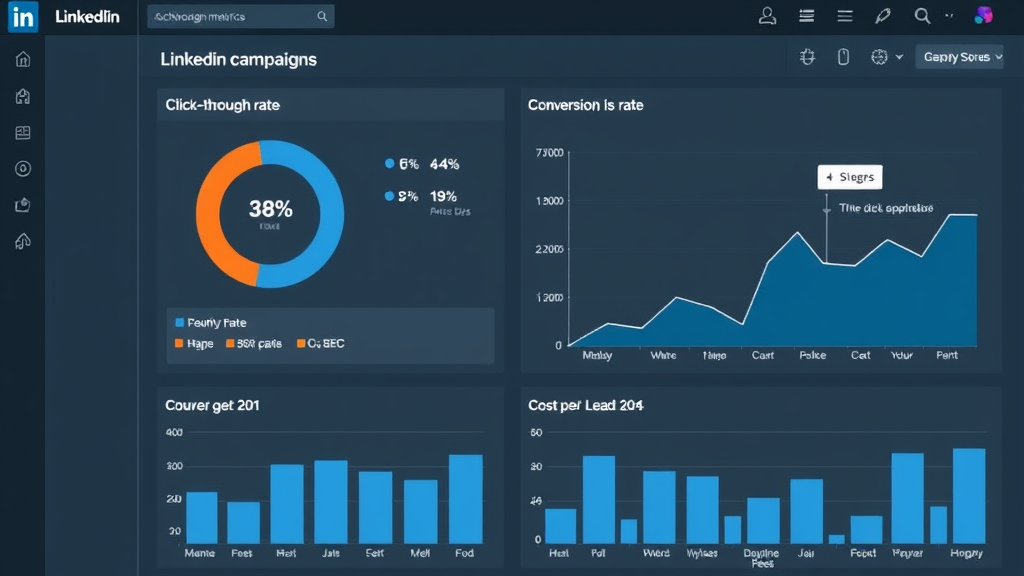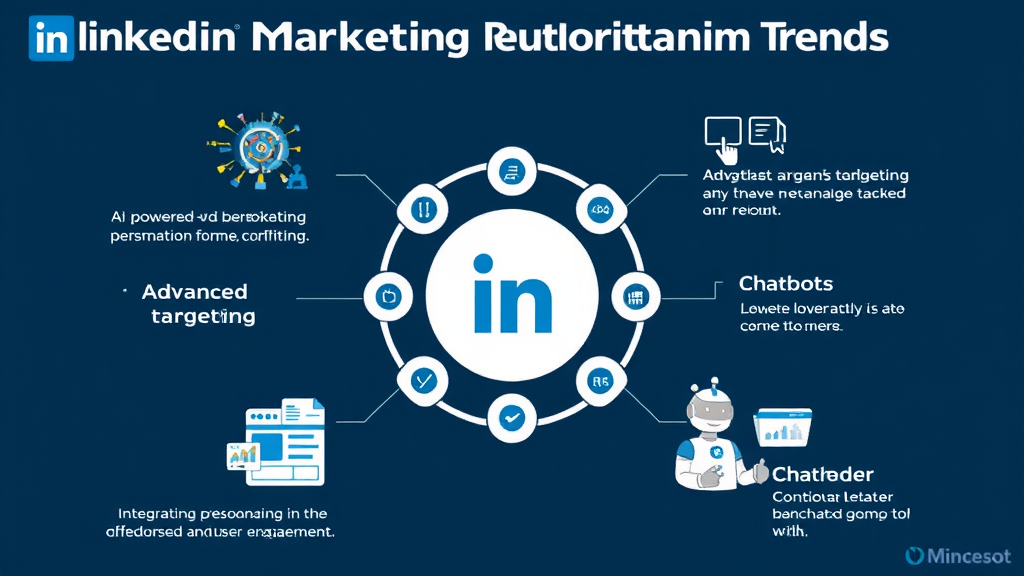LinkedIn marketing automation has become a pivotal strategy for businesses aiming to enhance their professional networking, lead generation, and brand visibility. By automating various LinkedIn activities, companies can streamline their marketing efforts, ensuring consistent engagement with their target audience. This blog post delves into the essentials of LinkedIn marketing automation, its benefits, tools, best practices, and how to measure its success.
Key Findings
- Enhanced Efficiency: Automating repetitive tasks like connection requests and content sharing saves time, allowing focus on strategic initiatives.
- Improved Targeting: Automation tools help identify and connect with the right audience, increasing the likelihood of conversions.
- Consistent Engagement: Scheduled posts and automated messaging ensure regular interaction with your network, maintaining top-of-mind awareness.
- Data-Driven Decisions: Analytics from automation tools provide insights into campaign performance, guiding optimization efforts.
- Scalability: Automation enables handling a larger volume of interactions without compromising quality.
- Personalization: Despite automation, maintaining a personal touch in communications is crucial for building genuine relationships.
Understanding LinkedIn Marketing Automation: What It Is and Why It Matters
LinkedIn marketing automation involves utilizing software tools to automate repetitive marketing tasks on LinkedIn, such as sending connection requests, messaging prospects, and sharing content. This approach aims to enhance efficiency, allowing marketers to focus on strategic initiatives while maintaining a consistent and personalized presence on the platform.
Key Benefits of LinkedIn Marketing Automation:
-
Time Savings: Automating routine tasks like connection requests and content sharing frees up time for more critical business activities.
-
Increased Productivity: Automation enables reaching a broader audience and nurturing relationships more efficiently.
-
Improved Targeting: Tools help identify and connect with the target audience more effectively, ensuring efforts are directed toward prospects likely to convert.
-
Data-Driven Decision Making: Tracking metrics and analyzing campaign performance provide insights to optimize marketing strategies.
-
Scalability: Automation allows scaling marketing efforts without sacrificing quality, handling a larger volume of interactions seamlessly.
-
Consistency: Maintaining a consistent presence on LinkedIn ensures continuous engagement with the target audience.
However, it's crucial to balance automation with authenticity. Over-automation can lead to impersonal messages and potential violations of LinkedIn's policies, risking account suspension. Therefore, integrating automation thoughtfully, while preserving the human element in interactions, is essential for successful LinkedIn marketing.
For a comprehensive guide on LinkedIn marketing automation, including best practices and tool recommendations, refer to The Ultimate Guide to LinkedIn Marketing Automation.
Top LinkedIn Automation Tools for Effective Lead Generation
LinkedIn automation tools can significantly enhance lead generation efforts by streamlining outreach processes and improving engagement. Here are some top LinkedIn automation tools designed to optimize your lead generation strategies:
Expandi
Expandi is a multichannel outreach tool specializing in automating LinkedIn campaigns, including InMails. It offers A/B testing for campaign strategies, robust reporting, and the ability to scrape data from posts, events, or groups. Expandi integrates cold email outreach with LinkedIn messaging capabilities, providing comprehensive targeting options such as industry, job title, and location. Its ease of use and effectiveness make it a top choice for LinkedIn automation.
Octopus CRM
Octopus CRM is an all-in-one LinkedIn automation tool that simplifies outreach and prospecting tasks. It allows users to automate sending bulk connection requests, viewing profiles, sending personalized messages, endorsing skills, and more. Octopus CRM is compatible with all LinkedIn account types and provides relevant statistics and overall trends for campaign monitoring. It also integrates with Zapier and HubSpot, enabling users to create lead generation funnels and use follow-up automation features to increase conversions.
LinkedIn Sales Navigator
LinkedIn Sales Navigator is a premium tool designed specifically for B2B lead generation. It offers advanced search filters, lead recommendations, and personalized insights to help users find and engage with ideal prospects. Sales Navigator allows users to create and save lead lists based on target audiences and track their updates and activity on LinkedIn. The InMail messaging system enables sending personalized messages to prospects even if they are not connected on LinkedIn, with higher response rates than regular messages.
Phantombuster
Phantombuster is recognized for automating data collection tasks across different websites, including LinkedIn. It streamlines LinkedIn automation and other web-related activities, serving as a multifunctional instrument that spares users from manual data gathering. Phantombuster facilitates automatic extraction of data from LinkedIn and smooth integration between various platforms, ensuring users can easily obtain valuable insights without extensive effort.
Dripify
Dripify is a cloud-based LinkedIn automation tool that allows users to build automated sales funnels and perform LinkedIn activities on autopilot. It enables the creation of drip campaigns using a variety of LinkedIn actions and time delays, with conditions that trigger appropriate automation actions. Dripify also provides features such as responding to messages from leads, analyzing campaign performance, and implementing extra safety algorithms for LinkedIn account security.
Dux-Soup
Dux-Soup is a LinkedIn automation software designed to help users generate fresh, qualified LinkedIn leads and grow their sales pipeline. It automates tasks such as sending connection invitations, viewing and endorsing profiles, and sending InMails and messages. Dux-Soup integrates with LinkedIn accounts without requiring third-party access, ensuring maximum safety and retaining all activity history within the platform. It also offers lead generation and management features, allowing users to follow up responses within LinkedIn or send new leads to preferred CRM systems through easy integrations.
When selecting a LinkedIn automation tool, consider factors such as your specific lead generation goals, budget, and the level of personalization required for your outreach campaigns. It's essential to use these tools responsibly to maintain compliance with LinkedIn's policies and ensure the authenticity of your networking efforts.
External Sources: Learn More
Transform your workflow today—visit ipsom.io or connect with us at office@ipsom.io.
Best Practices for Implementing LinkedIn Marketing Automation
Implementing LinkedIn marketing automation can significantly enhance your outreach and lead generation efforts. To ensure success, consider the following best practices:
1. Understand LinkedIn’s Policies
Before utilizing automation tools, familiarize yourself with LinkedIn's user agreement and guidelines. Unauthorized tools and excessive automation can lead to account restrictions or bans. Ensure you use trusted and compliant tools, avoid exceeding daily connection and messaging limits, and stay updated on LinkedIn’s policies.
2. Choose the Right Automation Tool
Select tools that prioritize compliance and offer features aligning with your goals. Look for options that provide safe activity limits, customization for personalized outreach, analytics for tracking performance, and robust data security measures.
3. Define Clear Goals
Set specific, measurable objectives for your LinkedIn campaigns, such as generating a certain number of new connections or achieving a targeted response rate. Clear goals help in creating targeted messages and monitoring success effectively.
4. Optimize Your LinkedIn Profile
A strong profile enhances credibility and increases the likelihood of positive responses. Ensure your profile includes a professional photo, compelling headline, engaging summary, relevant skills, and detailed work experience.
5. Target the Right Audience
Use LinkedIn’s filters and search features to narrow down your prospects based on criteria like industry, job title, location, and company size. Precise targeting increases the effectiveness of your outreach.
6. Personalize Your Outreach
Despite automation, your messages should feel personal. Address recipients by name, reference shared connections or interests, and tailor your messages to their specific needs. Personalization increases engagement and response rates.
7. Limit Daily Activity
Avoid excessive activity to prevent triggering LinkedIn’s spam filters. Limit connection requests and messages to safe daily amounts, and space out your activities to mimic natural usage patterns.
8. Use Follow-Up Sequences
Implement polite follow-up messages if there’s no initial response. Keep follow-ups short and value-focused, avoiding pushy or spammy behavior.
9. Monitor and Analyze Metrics
Regularly track key performance indicators (KPIs) such as connection acceptance rates, response rates, and conversion rates. Analyzing these metrics helps in refining your strategy and improving results.
10. Integrate Marketing and Sales Teams
Ensure collaboration between marketing and sales by integrating your automation platform with your CRM system. This alignment streamlines communication and ensures a seamless handoff of leads between departments.
By adhering to these best practices, you can effectively implement LinkedIn marketing automation to enhance your outreach and lead generation efforts.
External Sources: Learn More
Transform your business operations—learn more at ipsom.io or get in touch at office@ipsom.io.
Measuring the Success of Your LinkedIn Automation Campaigns
Measuring the success of your LinkedIn automation campaigns is essential for optimizing performance and achieving your marketing objectives. By focusing on key performance indicators (KPIs), you can gain valuable insights into your campaign's effectiveness and make data-driven decisions.
Key Metrics to Monitor:
-
Click-Through Rate (CTR): This metric indicates the percentage of users who clicked on your ad after seeing it. A higher CTR suggests that your content is engaging and relevant to your target audience.
-
Cost Per Click (CPC): CPC measures the amount you pay for each click on your ad. Monitoring CPC helps assess the cost-effectiveness of your campaign in driving traffic.
-
Conversion Rate: This metric reflects the percentage of users who completed a desired action, such as filling out a lead form or making a purchase, after clicking on your ad. A higher conversion rate indicates that your campaign effectively persuades users to take action.
-
Cost Per Lead (CPL): CPL calculates the average cost to acquire a lead through your campaign. Keeping CPL within your budget ensures that your lead generation efforts are financially sustainable.
-
Engagement Rate: This metric encompasses user interactions with your ads, including likes, comments, shares, and clicks. A high engagement rate signifies that your content resonates well with your audience.
Tools and Strategies for Effective Measurement:
-
LinkedIn Campaign Manager: Utilize LinkedIn's Campaign Manager to monitor key metrics such as clicks, impressions, and engagement rates. This platform provides valuable insights to assess and optimize your campaign's performance.
-
LinkedIn Insight Tag: Implement the LinkedIn Insight Tag on your website to track conversions, optimize campaigns, and gain demographic insights about your audience. This tool helps you understand the actions users take after interacting with your ads.
-
Lead Gen Forms: Incorporate LinkedIn's Lead Gen Forms to streamline the lead collection process. These forms are pre-filled with users' LinkedIn profile data, making it easier for them to submit their information and for you to track lead-related metrics.
-
A/B Testing: Conduct A/B tests by creating variations of your ads with different visuals, headlines, or calls-to-action. Testing these variants helps identify the most effective elements, allowing you to refine your campaign for better results.
By consistently monitoring these metrics and utilizing the appropriate tools, you can effectively measure the success of your LinkedIn automation campaigns and make informed decisions to enhance their performance.
External Sources: Learn More
Transform your workflow and elevate your business—visit ipsom.io or email us at office@ipsom.io.
Common Pitfalls in LinkedIn Automation and How to Avoid Them
Implementing LinkedIn automation can significantly enhance your networking and lead generation efforts. However, it's crucial to be aware of common pitfalls to ensure your strategy remains effective and compliant.
Over-Automation
Excessive automation can make your account appear robotic, potentially triggering LinkedIn's spam filters and leading to restrictions. To avoid this, balance automated actions with genuine, personalized interactions. Gradually increase your automation activities, starting with a limited number of connection requests and messages per day, and monitor your account's health regularly.
Generic Messaging
Sending impersonal, templated messages can deter potential connections. Personalize your outreach by incorporating the recipient's name, referencing shared interests, or mentioning recent activities they've engaged in. This approach demonstrates genuine interest and increases the likelihood of a positive response.
Ignoring LinkedIn's Usage Policies
Non-compliance with LinkedIn's terms of service can result in account restrictions or bans. Familiarize yourself with LinkedIn's guidelines and ensure your automation practices adhere to them. Use trusted tools that comply with these policies and avoid exceeding daily limits for connection requests and messages.
Neglecting Engagement Beyond Messages
Automation often focuses solely on direct messaging, but true networking success on LinkedIn comes from engaging with content and building relationships. Engage with posts before reaching out, share valuable content, and participate in LinkedIn groups to foster genuine connections.
Failing to Monitor and Optimize Performance
Without analyzing the effectiveness of your LinkedIn automation, you won't know what's working and what needs improvement. Track key performance metrics such as connection acceptance rates, response rates, and conversion rates. Regularly analyze your automation data to ensure your strategy is working as intended.
By being mindful of these pitfalls and implementing best practices, you can leverage LinkedIn automation effectively while maintaining authenticity and compliance.
External Sources: Learn More
Unlock your business potential—transform your operations with ipsom.io or get in touch at office@ipsom.io.
Future Trends in LinkedIn Marketing Automation
LinkedIn marketing automation is poised for significant advancements, driven by emerging technologies and evolving user behaviors. Key trends shaping the future include:
AI-Powered Personalization
Artificial Intelligence (AI) is revolutionizing LinkedIn marketing by enabling hyper-personalized experiences. AI algorithms analyze vast amounts of data to predict user behavior and preferences, allowing marketers to tailor content, offers, and recommendations to individual users. This approach enhances engagement and conversion rates by delivering relevant content at optimal times.
Advanced Targeting Options
LinkedIn's targeting capabilities are expected to become more precise, incorporating advanced demographic, psychographic, and behavioral data. This precision will enable marketers to reach their ideal audience with pinpoint accuracy, reducing ad spend wastage and improving return on investment (ROI). Additionally, the growth of Account-Based Marketing (ABM) will allow businesses to target specific accounts with personalized ads and content, fostering deeper relationships and driving higher-value deals.
Integration with Other Platforms
Seamless integration between LinkedIn and other marketing platforms, such as CRM systems and email marketing tools, will streamline lead generation and nurturing processes. This integration ensures a cohesive and personalized experience across multiple channels, enhancing the effectiveness of marketing campaigns.
Enhanced Analytics and Reporting
The adoption of advanced analytics tools will provide deeper insights into customer interactions and campaign performance. Machine learning-driven predictive analytics will allow marketers to forecast customer behaviors, optimize resource allocation, and identify high-value leads, shifting strategies from reactive to proactive.
Conversational AI and Chatbots
Advancements in natural language processing and machine learning are driving the adoption of AI-driven chatbots and conversational marketing tools. These technologies enable real-time, personalized interactions with prospects, providing instant support and nurturing leads more effectively. As chatbots become more sophisticated, they will play a crucial role in automating customer engagement on LinkedIn.
Data Privacy and Compliance
With increasing concerns around data privacy, LinkedIn will emphasize compliance with regulations such as GDPR and CCPA. Marketers will need to adopt ethical automation practices, ensuring transparency in data collection and usage. This focus on privacy will help maintain user trust and the platform's reputation as a professional networking space.
By embracing these trends, marketers can leverage LinkedIn marketing automation to deliver personalized, efficient, and compliant campaigns that resonate with their target audience.
External Sources: Learn More
FAQ – Frequently Asked Questions
What are the risks associated with LinkedIn marketing automation?
Utilizing LinkedIn marketing automation carries several risks:
-
Account Restrictions or Bans: LinkedIn prohibits automation tools; their use can lead to account limitations or permanent bans.
-
Loss of Personalization: Automated messages may appear generic, reducing engagement and harming relationships.
-
Spam Perception: Excessive automation can overwhelm recipients, leading to your messages being marked as spam.
-
Data Security Concerns: Automation tools may require access to your LinkedIn credentials, posing potential security risks.
-
Reputation Damage: Impersonal or excessive automated outreach can harm your professional image.
-
Legal Risks: Non-compliance with data protection laws through unsolicited automated messages can lead to legal issues.
To mitigate these risks, balance automation with personalized, manual interactions and adhere to LinkedIn's guidelines.
How can I ensure my automated messages don't come across as spam?
To ensure your automated messages are not perceived as spam, consider the following best practices:
-
Obtain Explicit Consent: Use a double opt-in process where subscribers confirm their email address after signing up. This builds trust and ensures recipients genuinely want to receive your emails.
-
Authenticate Your Domain: Implement SPF, DKIM, and DMARC protocols to verify your emails' legitimacy, reducing the likelihood of being flagged as spam.
-
Craft Clear Subject Lines: Avoid misleading or overly promotional language. Ensure subject lines accurately reflect the email's content to maintain credibility.
-
Personalize Content: Address recipients by name and tailor content to their interests, enhancing engagement and reducing spam complaints.
-
Maintain a Balanced Text-to-Image Ratio: Excessive images can trigger spam filters. Aim for a good balance between text and visuals to improve deliverability.
-
Include a Clear Unsubscribe Option: Provide an easy-to-find unsubscribe link in every email, as required by the CAN-SPAM Act, to respect recipients' preferences and comply with regulations.
-
Avoid Spam Trigger Words: Steer clear of phrases like "free," "buy now," or "earn cash," which are commonly associated with spam.
-
Use a Reputable Email Service Provider (ESP): Partner with a trusted ESP to benefit from established relationships with ISPs and adhere to best practices, enhancing email deliverability.
-
Monitor Engagement Metrics: Regularly track open rates, click-through rates, and spam complaints to identify and address potential issues promptly.
-
Test Emails Before Sending: Utilize spam-testing tools to assess your emails' likelihood of being flagged and make necessary adjustments before distribution.
By implementing these strategies, you can enhance the effectiveness of your automated messages and minimize the risk of them being marked as spam.
Are there any LinkedIn policies I should be aware of when using automation tools?
Yes, LinkedIn prohibits the use of automation tools that mimic human behavior, such as sending bulk messages, automated connection requests, or scraping data without permission. Violating these policies can lead to account restrictions or bans.
To stay compliant, avoid using browser extensions for automation, as they are easily detectable. Instead, opt for cloud-based tools that prioritize security and mimic natural human behavior.
Additionally, be mindful of LinkedIn's activity limits, such as the number of connection requests or messages sent daily, to prevent triggering LinkedIn's detection systems.
How do I choose the right LinkedIn automation tool for my business?
Selecting the appropriate LinkedIn automation tool is essential for enhancing your networking and marketing efforts. Consider the following factors:
-
Define Your Objectives: Identify the specific tasks you wish to automate, such as connection requests, messaging, or content scheduling.
-
Evaluate Features: Look for tools that offer functionalities aligning with your goals, including personalized messaging, analytics, and CRM integration.
-
Ensure Compliance: Choose tools that adhere to LinkedIn's terms of service to avoid account restrictions.
-
Assess User Experience: Opt for tools with intuitive interfaces and reliable customer support to facilitate ease of use.
-
Consider Pricing: Select a tool that fits your budget while providing the necessary features.
-
Check Integration Capabilities: Ensure the tool integrates seamlessly with your existing software ecosystem, such as CRM systems and email platforms.
By carefully evaluating these aspects, you can choose a LinkedIn automation tool that effectively supports your business objectives.
Can LinkedIn automation help in building genuine professional relationships?
LinkedIn automation tools can streamline tasks like sending connection requests and messages, potentially expanding your network efficiently. However, over-reliance on automation may lead to impersonal interactions, diminishing the authenticity crucial for building genuine professional relationships. Excessive automation can result in generic messages and mass connection requests, which may be perceived as spammy, potentially harming your professional reputation. To foster meaningful connections, it's advisable to balance automation with personalized engagement, ensuring that interactions remain authentic and tailored to each individual.







